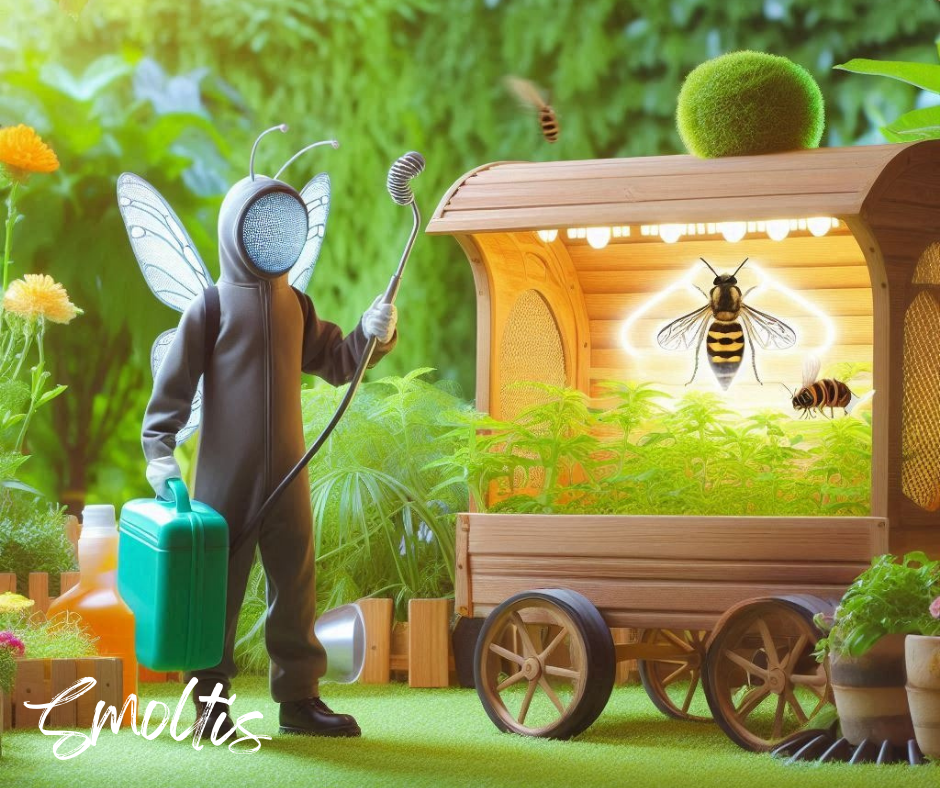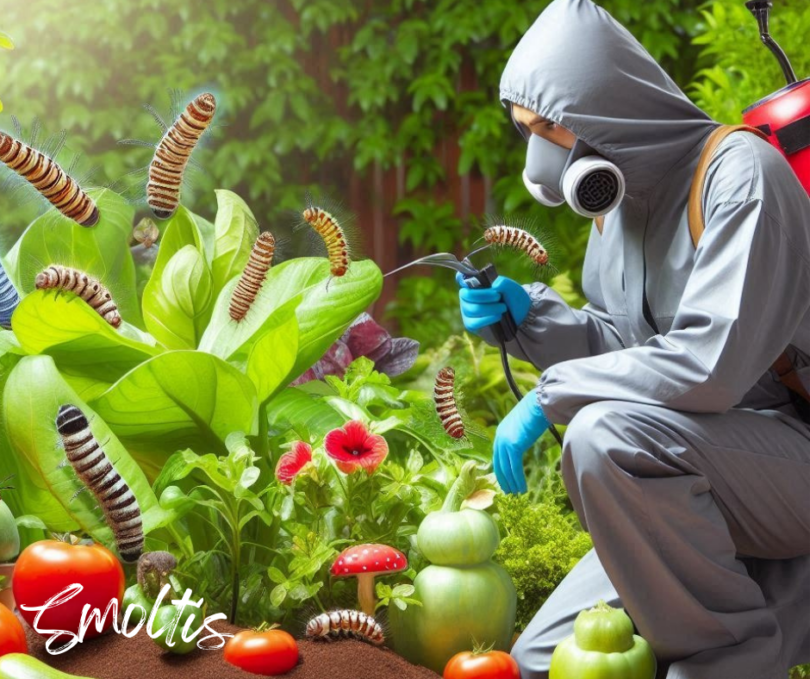Shaded gardens are lovely spots in a yard. They bring a calm feel but face unique pest challenges.1 We’ll look into common pests in these areas and how to deal with them. Plus, we’ll share tips on keeping a shady garden healthy and bug-free.

A serene, shaded garden with lush green plants and trees. Rays of sunlight filter through the leaves, illuminating parts of the garden floor. In the distance, a small pond glistens under the shade. There are signs of pests, such as holes in leaves and chewed up stems, but the garden appears to be well-maintained and under control.
Key Takeaways
- Shaded gardens are vulnerable to many bug pests like slugs, snails, aphids, and spider mites.
- Spotting these pests correctly is key to getting rid of them in shaded areas.
- Using eco-friendly methods like planting certain crops together and bringing in helpful bugs can be effective.
- It’s crucial to keep the garden clean, choose plants that like the shade, and make cozy spots for good bugs.
- Integrated Pest Management (IPM) is a smart mix of strategies to keep gardens healthy and cut down on chemical pest killers.
Introduction to Shaded Gardens
Shaded gardens get less than 6 hours of sunlight a day. This happens because of trees, buildings, or other shadows2. They bring a peaceful feeling, perfect for growing plants that love shade.
Defining Shaded Gardens
These gardens have lower light due to big trees, tall buildings, or shadows from other structures. They create a calm space for a big variety of shade-loving plants.
Benefits of Shaded Gardens
Shaded gardens are cooler, use less water, and are great for specific plants that like some shade.2 They’re also good for wildlife, like bees and other helpful bugs.
Challenges of Shaded Gardens
Yet, shaded gardens come with their own set of issues. Some plants won’t grow well in low light3. Also, pests might be more of a problem. Keeping the right balance of water, nutrients, and air can be tough in the shade.
Common Pests in Shaded Gardens
Shaded gardens often face problems with bugs and small creatures. This includes aphids, mealybugs, and more. These insects and arthropods harm plants by eating leaves and roots. This can cause plants not to grow well, change color, or die. It’s important to know these pests’ habits to keep them under control.4
Insects and Arthropods
Shady spots are perfect for bugs because they’re damp and not too bright.4 To keep them away, plant things like lemon thyme or garlic. They can make the bugs go elsewhere.4 Making sure the air flows well and the ground doesn’t stay wet helps.4 Also, planting things like marigolds next to your other plants can stop some bugs from coming.4 Using plants that bugs don’t like can make your garden a place they avoid.4
Mammals and Wildlife
Besides bugs, shaded gardens can draw bigger pests like rabbits or deer.4 These animals might eat or mess up your plants. They can even dig in your garden. To keep them away, pick plants that deer don’t like and can live in the shade.
Plant Diseases
Shaded gardens can also get sick with different plant diseases. These can show up as spots on the leaves or the plant looking sick.5 To fight this, make sure your plants are well-taken-care-of.5 Keep things clean and pick plants that are less likely to get sick.5
| Publication | Year | Relevant Information |
|---|---|---|
| Journal of Arboriculture | 1989 | A study on the foliar and growth effects of summer horticultural oil sprays on trees and shrubs under drought stress was published.5 |
| ‘Natural Enemies Handbook: The Illustrated Guide to Biological Pest Control’ | 1998 | This 154-page publication was released by the University of California ANR Communication Services, authored by Flint, Dreistadt, and Clark.5 |
| ‘Diseases of Trees and Shrubs’ | 1987 | This comprehensive volume, spanning 574 pages, was published by Comstock Publishing, Cornell University Press.5 |
| The IPM Practitioner | 1990 | An article by Grossman discussed horticultural oils’ new summer applications on ornamental plant pests.5 |
| Journal of Arboriculture | 1975 | The authors Olkowski and Olkowski presented a paper on establishing an integrated pest control program for street trees.5 |
| The IPM Practitioner | 1989 | Olkowski, Olkowski, and Daar discussed the successful use of beneficial nematodes by the Chinese to control various pests.5 |
| California Agriculture | 1974 | Olkowski and Olkowski elaborated on the preliminary results of an integrated insect control program for street trees.5 |
| ‘Urban Forestry: Planning and Managing Urban Green-Spaces’ | 1988 | This 404-page book by Miller focused on summarizing the value of trees in urban environments and provided models for intelligent tree management.5 |
Identifying Pest Damage
Spotting signs of6 pest damage is crucial in pest control. For insects, watch out for chewed leaves, discoloration, webbing, and the bugs themselves.7 Knowing the specific damage tells gardeners what pest is at fault. Then, they can use the right methods to stop them.
Big pests like mammals can chew on plants or dig. Look for tracks, droppings, or other clues to find out who the culprit is.6 This helps gardeners act fast and correctly.
Plant diseases show in many ways, like spots, wilting, and stunted growth.8 Check plants closely for these signs and any fungal or bacterial growth. This checking helps gardeners quickly deal with the diseases.
Signs of Insect Damage
Insects can harm plants in several ways, including chewed leaves, discoloration, and webbing.6 Learning about these unique damage signs helps gardeners find the culprits fast. Then, they can use the right methods to stop the pests.
Signs of Mammal Damage
Animals like rabbits, raccoons, and chipmunks cause damage by gnawing and digging. Look for tracks and droppings to identify them.6 This step is key in taking the correct actions.
Signs of Disease Infection
Plant diseases in shaded areas show up as leaf spots, wilting, and strange colors.8 Look closely for these signs and any fungal or bacterial growth. Doing this helps gardeners diagnose and treat the diseases right away.https://www.youtube.com/embed/Qfs5JFpatDE
Eco-Friendly Pest Control Methods
Gardeners strive to keep their gardens healthy and pest-free by using earth-friendly methods. They aim to attract helpful bugs, use natural bug repellents, and adopt practices that discourage pests.9 Many have learned these strategies from eco-friendly landscaping programs.9
Encouraging ladybugs, lacewings, and parasitic wasps is a smart way to fight off harmful bugs.10 These beneficial insects help keep aphids, mealybugs, and more in check.10
Using organic pest control is also key. Natural sprays with neem oil or extracts from pyrethrin and spinosad can work well.11 They’re good for dealing with mealybugs, whiteflies, and other pests, and they’re gentle on the environment.11
Changing how we care for our gardens can also make a big difference.9 Switching from high-water lawns to native plants can save water, lower maintenance needs, and support local wildlife. It also cuts down on the use of pesticides.9
By focusing on eco-friendly strategies, gardeners can keep their gardens beautiful and bug-free.10 Being alert to pests, using mesh netting, and growing flowers that attract good bugs can all boost the success of these methods.10
Shaded Gardens
Selecting Shade-Tolerant Plants
Picking the right plants for shade is key to a lush shaded garden. We’ll share top picks for shade-loving plants. These include perennials, annuals, and trees that thrive in woodland gardens and partial shade areas.12
One top choice is Coleus, known for its vibrant leaves, from 8 inches to 3 feet tall.12 The Sun King Japanese Spikenard adds height at 3 to 6 feet, and it’s deer-resistant.12 Coral bells and Bee balm are also great options for color in shady spots.12
The plant variety list doesn’t stop there. It includes Bellflowers, and Brunnera macrophylla with its striking leaves.12 Plus, there are perennial options in many colors.12
Designing a Shaded Garden Layout
Designing a shaded garden that works is about managing light, moisture, and airflow.13 We’ll give you tips on planting to make everything look and function well.13
13 Places with partial shade offer unique design chances. It’s important to know the light and moisture needs of each spot.13
14 To keep your garden looking good, use low-ground cover and mix textures and colors.14 Arranging plants in large groups is a smart move for beauty.14
14 Paths and special spots with materials like wood chips stand out in shaded gardens.14 Adding unique finds like old barrels can also make your garden unique.14
Attracting Beneficial Insects
Want to keep pests away from your shaded garden? Try attracting helpful insects like ladybugs, lacewings, and wasps.15 Lady beetles are amazing because they can eat 50 aphids a day. When a larva hatches, it can eat about 400 aphids.15
Ground beetles are great too. They’re big, around 3/4 inch, and they hunt at night. They look for insect eggs and larvae in the leaves on the ground.15 Hover flies also help by eating aphids. They lay eggs near aphids, and their larvae can eat 60 aphids every day.15
The minute pirate bug eats aphids, thrips, mites, and more. It only takes three weeks for the little bug to grow from an egg to an adult.15 The big-eyed bug enjoys a similar diet. It also likes to eat nectar and seeds.15
Plants that Attract Pollinators
16 The research showed that Blazing Star (Liatris) does a great job attracting beneficial insects.16 Different kinds of milkweeds attract butterflies, moths, and bees. Plus, they’re usually safe from deer.16
Mountain Mint (Pycnanthemum) does well too. In the tests, it attracted honeybees, butterflies, and other helpful bugs.16 Goldenrods (Solidago) are also real stars. They bring in a variety of good insects and are tough against deer and the lack of water.16
Bee Balm (Monarda) is loved by many. It attracts butterflies, moths, hummingbirds, and various beneficial insects.16 Rattlesnake Master (Eryngium yuccifolium) is a great nectar source for beneficial bugs like wasps, bees, and butterflies.16
Creating Insect Habitats
15 Trichogramma wasps are tiny but they can lay up to 300 eggs in moth or butterfly eggs. This helps control caterpillars.15 Larger parasitic wasps like Braconid and chalcid wasps lay their eggs in caterpillars. This can stop the caterpillars from damaging plants.15
Fennel flowers attract nice insects too. These include lacewings, hover flies, minute pirate bugs, and parasitic wasps.15 Plants like fennel are especially good for attracting these helpful bugs.15 Statice is good because it blooms every year and provides nectar for lady beetles, lacewings, and parasitic wasps.15
Don’t forget about water for your helpful insects. They need wet spots to drink. You can make these spots with overhead sprinklers or a saucer with water and pebbles.15 Ground beetles like wet areas too. They hide in low plants, mulch, or leaves. Flying insects will seek shelter in bushes or under leaves and flower petals.15
Create an image of a lush garden filled with shade-loving pollinator plants. Show various plants in different shades of green, with vibrant pops of color from the flowers. Add in some details like hummingbirds and bees hovering around the plants. The plants should have a soft texture to convey the peaceful and natural environment. Try to capture the atmosphere of a serene and harmonious garden in a shaded area.
Deterring Unwanted Pests
Gardeners can use many eco-friendly ways to keep pests out of their shady spots. Companion planting is a great method. It means planting certain things together to help them all out. In this part, we’ll talk about using herbs, flowers, and plants that bugs don’t like. These can form a kind of wall in your garden, keeping bugs away.
Companion Planting
Pairing up pest-repellent plants with what you want to grow is smart. It tricks pests and keeps them from making a home in your garden.17 Mixing up certain plants, herbs, and flowers confuses bugs. This not only protects your garden but brings in good bugs that eat the bad ones.
Repellent Plants
Besides using companion planting, some plants just naturally keep pests away. We’ll talk about some of these plants. Shade-tolerant, smell-good, and strong plants can stop bugs and other pests from coming.18 Basil scares off asparagus beetles, carrot flies, and whiteflies.18 Catmint keeps aphids away and likes sunny, well-drained spots.18 Chives stop aphids from causing trouble in plants like chrysanthemums and tomatoes.18 Garlic is great against aphids, cabbage moths, and even rabbits if given sunlight and good soil.18 Mint doesn’t like pests like aphids, cabbage moths, whiteflies, and ants and keeps them off other plants too.18 Onions can shield plants from aphids, carrot flies, and rabbits, and they’re simple to grow.18 Coriander fights off aphids and is also good to eat.18 Tansy has a strong smell that keeps ants away and is a no-fuss plant for sunny dirt.18
Maintaining a Healthy Shaded Garden
Keeping a shaded garden healthy and free of pests needs careful work. It’s important to know how much to water and which mulch to use. This part will teach you ways to keep the right amount of moisture, avoid too much or too little water, and pick the best mulch.
Proper Watering and Mulching
The water needs in shaded areas depend on a lot of things. These include the type of plants, how fast they grow, the weather, the soil, and the kind of shade they get.19 In these areas, people often use automatic watering systems. These can be simple, like a clock you set to water, or very high-tech, with computers controlling everything.19 For shaded spots, drip irrigation is often best. It puts the water right at the plant roots. This saves water, stops the plants from getting too wet, and reduces the chance of diseases.19 If you’re doing it yourself, you might want to set up a small drip system. This would include putting together black pipes, connectors, and tiny outlets for the water.19 In some cases, sprinklers that shoot small, focused streams of water, called micro-jet irrigation can be better. They’re great in sandy soil because they use less water and prevent problems like too much salt in the soil.
20 In shaded areas, you don’t have to water as often as in the sun. It’s because the soil stays moist longer. Adding the right mulch, like wood chips or bark, can keep this moisture in. It also stops weeds from growing.
Pruning and Sanitation
Trimming and keeping your garden clean are also vital. They help plants stay healthy in shaded areas. We will talk about how to prune plants to let more air in, cut off sick or broken parts, and keep bugs away. Plus, we’ll mention why it’s good to clean up around your plants. This stops pests from making your garden their home.
Impact of Pesticides on Shaded Gardens
Conventional pesticides offer a quick solution to shade garden pest issues. Yet, they pose huge risks to our environment.21 Each year, thousands of people are exposed to pesticides, with a big portion being kids under 6.21 These chemicals are toxic and even a small amount can be lethal.21
Environmental Concerns
Their use can hurt helpful bugs, pollute our soil and water, and put human health in danger.21 Most home pesticides are mildly toxic, detailed with a “CAUTION” sign. This means they can harm if not handled correctly.21 Always follow the label’s instructions to avoid causing harm to our planet.
Organic Alternatives
For those looking beyond synthetic means, organic and natural options abound.22 The key to a pest-free garden is not just about using sprays. It’s also about picking, planting, and looking after your greenery.22 Healthy plants can resist bugs better.22 It helps to choose plants that fit the shade and are disease-resistant. This simple step can lower your pest count.22
Using natural insecticides, attracting beneficial bugs, and using smart growing methods are great practices. They lessen the need for harmful chemicals in shaded areas.
A shaded garden with wilted plants and brown leaves due to the use of pesticides. A few common garden pests, such as aphids or spider mites, are still visible on the plants. The pesticide spray bottle and its label are shown nearby, with warning symbols and instructions for use. The overall tone of the image should convey the negative impact of pesticides on shaded gardens and the environment.
Integrated Pest Management (IPM)
Integrated Pest Management (IPM) uses many methods to keep pests in check and help the garden stay healthy.23 It’s important to always check for pests and know how to deal with them. This helps gardeners choose the best ways to control pests.23
Monitoring and Scouting
Keeping an eye out for pests is crucial in IPM.23 Scout your garden weekly if you grow vegetables, every one to two weeks for flowers and trees, and monthly when plants are dormant.23 Doing this lets gardeners catch pest problems early and tackle them fast.24
Cultural, Physical, and Biological Controls
IPM uses non-chemical ways to control pests too.25 These methods include things like planting the right plants, keeping your garden clean, and using barriers to stop pests.24 For example, you should plant disease-resistant plants, water in the morning, and check your soil’s pH.24
Other physical methods include mulching your garden, weeding regularly, and using traps for pests.24 There are also helpful bugs and bacteria that can naturally keep pests away. This includes things like ladybugs and certain types of wasps.24
Using a mix of these methods, gardeners can control pests without using a lot of chemicals.25
Troubleshooting Common Issues
Shaded gardens might still get pests, even with good precautions. This part will help gardeners spot and deal with common bugs in shady areas. It gives a step-by-step on how to control them.
Dealing with Specific Pests
Insects like aphids and mealybugs, and snails and slugs could be a problem in shaded areas. They attack plants, causing them to look bad or even die. It’s key to watch out for signs like eaten leaves or webbing. This way, you can catch the pests early.
Besides bugs, shaded spots might also attract bigger pests like rabbits and deer. They eat or walk over plants, damaging them. Looking for signs of animal damage, like gnaw marks or messed-up soil, is vital. This helps in fighting back effectively.
Addressing Plant Diseases
Because of the setting, shaded gardens are more likely to have plant diseases. These can show up as spots, wilting, or strange color changes. Checking plants for these issues can stop diseases from spreading further.
Keeping the area clean and picking the right plants can lower the risk of plant sickness. It’s important to get rid of sick plants, keep the air fresh around them, and choose plants that can handle the shade. Doing this can protect the garden.26
Conclusion
Having a healthy shaded garden is all about using many tactics. This includes stopping pests before they come, using green ways to control them, and always keeping an eye out for any sign of bugs.27 Knowing how to tackle problems in the shade helps plants grow and keeps nature happy.27 This guide gives gardeners all they need to deal with pests. It lets them enjoy a beautiful, shaded garden.
Dealing with pests in a shaded garden involves several steps. Encouraging friendly bugs, using natural sprays, and smartly managing pests can keep the garden eco-friendly.28 Choosing green solutions makes a garden not just pretty but also good for the ecosystem.28 It helps everything grow better without harming nature.
Building and keeping a flourishing shaded garden takes work. But, it’s worth it.28 By planning, watching carefully, and using smart pest control, gardeners can make their garden a peaceful place for everyone.28 This guide equips gardeners to start and keep up a stunning, earth-friendly garden. One that will make the whole area proud.
FAQ
What are the common pests that can plague shaded gardens?
Shaded gardens often deal with bugs like aphids, mealybugs, and more. You might also see slugs, snails, and spider mites. Bigger pests are an issue too, including rabbits, chipmunks, and deer.
How can gardeners identify signs of pest damage in shaded gardens?
Watch for certain signs. Insects might leave chew marks on leaves. You can see webbing and discoloration too. For bigger pests, look for gnawed stems or missing plants.
If plants look sickly or warped, they could have diseases. These typically show as spots, wilting, and stunted growth.
What are some eco-friendly pest control methods for shaded gardens?
Use natural ways to keep pests at bay. This includes attracting good bugs, using natural repellents, and smart gardening practices. Integrated Pest Management is key. It’s about combining different controls to fight off pests.
How can gardeners select the right plants for a shaded garden?
Pick plants that love the shade. Think about perennials, annuals, and woody types that thrive in less light. Choose based on how easy they are to grow and how they look.
How can gardeners attract beneficial insects to a shaded garden?
Plant flowers that like the shade and are full of nectar. Also, making places like log piles can invite good insects to your garden.
What are some effective companion planting and pest-repellent plants for shaded gardens?
Herbs and flowers with a strong smell can deter pests. Planted correctly, these can protect your garden in a natural way.
How can gardeners maintain a healthy, pest-free shaded garden?
Care for your plants well. Ensure they get the right amount of water and sunlight. Keep the garden clean and use mulch to protect the soil.
What are the environmental concerns associated with using pesticides in shaded gardens?
Standard pesticides can harm more than bugs. They’re bad for the environment and for people. Stick to eco-friendly ways to maintain a safe garden ecosystem.
How can gardeners implement Integrated Pest Management (IPM) in their shaded gardens?
Start by keeping an eye on your garden and knowing what pests could show up. When you spot a problem, use a mix of methods to get rid of the pests. This includes not just chemicals but also ways like keeping your garden neat.
How can gardeners troubleshoot and address common pest and disease issues in shaded gardens?
Learn the signs of pest and disease trouble. Once you know what’s wrong, you can take steps to fix it. This includes using the best methods to make your garden healthy again.







